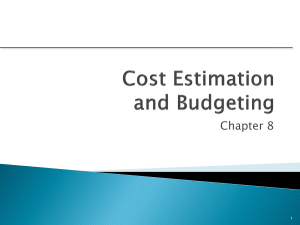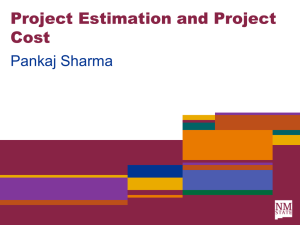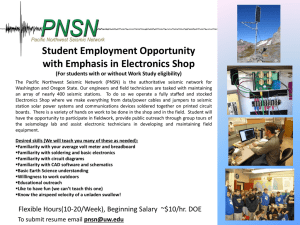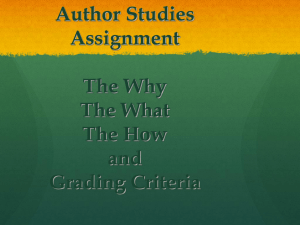Concepts of Measurement
advertisement
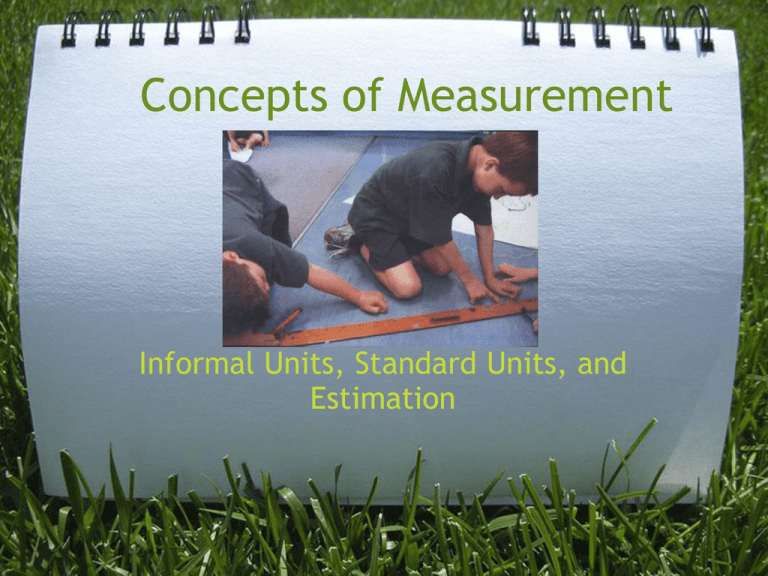
Concepts of Measurement Informal Units, Standard Units, and Estimation The Goal of the Teacher Help students understand what it means to measure length, volume, weight, and area! The BIG Ideas • Measurement involves a comparison of an attribute with a unit that has the same attribute. • Meaningful measurement and estimation of measurements depend on a personal familiarity with the unit of measure being used. • Estimation of measures help students increase familiarity with units, prevent errors and aid in the meaningful use of measurement. • Understanding how measurement instruments work. The 3 Steps of Measurement 1. Decide on the attribute to be measured 2. Select a unit that has that attribute 3. Compare the units, by filling, covering, matching, or some other method, with the attribute of the object being meaurement. Plan for Instruction 1. Understand the attribute to be measured 2. Understand filling, covering, matching, or making other comparisons of an attribute with informal measuring units 3. Students will use common measuring tools with understanding and flexibility WHY USE INFORMAL UNITS? • Easier to focus directly on the attribute being measured. • Keeps the size of the numbers reasonable. • In K-3 a discussion of inches, feet, centimeters, etc., can obscure what it means to measure. • Provides the rationale for standard units. • It's gosh darn fun!! Assessment Can the student pick the best unit to measure with? Does the student overlap their units or measure in a crooked line? Can the student tell which is longer when measuring two objects? How does the student go about measuring? LENGTH • • • • • giant footprints rope paper clips straws cubes Have students measure with one unit and then another to make a comparison. • Meaure the length of your desk with paper clips. Now with straws. What do you notice about these two numbers? AREA chips, pennies, beans, one inch color tiles, cardboard squares, or newspaper Cut up one shape and re-arange it to show the area is the same Fill a space with cut pieces of paper (lends itself to the area algorithim) Give students two shapes. Which has the greater area? Fold or cut in any way to find out. Volume and Capacity beans coins styrophome peanuts rice water plastic caps cups and jars TIME slow drip bottles pendulum swing one handed clock elapsed time on a number line Weight and Mass Two-pan balance Rubber-band (spring) scale ANGULAR MEASURE wedges protractor made from wax paper protractor made with hand drawn units Comparison Activities • Comparison activities help students focus on the attribute being measured. • During these activities emphasis approximate language! • Many measurements don't come out even, so "approximate" language is especially useful for children. The desk is about 10 blue rods long The chair is less than five pencils high Comparison Activities That Work Well! K-3 Length: Area: Begin by comparing two or more lengths *important to understand attribute first Compare lengths that aren't straight lines Rearranging shapes doesn't affect area! Use comparison to demonstrate (Act. 8.8) Comparison Activvities K-3 Volume and Capacity: • Start with comparing capacities • Compare capacity using different containers • Volumes of solid objects can be a difficult concept to comprehend. Weight and Mass: • Use simple activities to start. Hold out two objects in hands. • Use approximate language • Move into using balance pans and spring scales Comparison Activities For 3-5 Length: • Students should have a good grasp on understanding the attribute of length by this age, but need to continue working with units of length. Area: • Work on distinguishing between size and shape, length and width. • Comparing rectangles with different lengths and widths (Act. 9.3) • Tanagram Areas (Act. 9.4) Comparison Con't 3-5 Volume & Capacity: Measuring Angles: • Capacity Line-up (Act. 9.9) • Compare angles by overlapping • Displacement activities for volume • Use a cut-out angle as an informal unit to measure other angles • Box Comparison-Cubic Units (Act. 9.10) • make a wax paper protractor Standard Units of Measurement: Instructional Goals 1. Familiarity with the unit 2. Ability to select an appropriate measure 3. Knowledge of a few important relationships between units Standard Units of Measurement • Students must develop a familiarity with standard units of measurement! • Students must learn appropriate relationships between standard units of measurement! • Use standard units once measuring concepts are in place! The Ruler!!! Informal Units to Standard Units: How Does This Work? Standard Customary Units LENGTH: inch, foot, yard, mile AREA: square inch, square foot, square yard VOLUME: cubic inch, cubic foot, cubic yard CAPACITY: ounce*, teaspoon, tablespoon, cup, quart, gallon WEIGHT: ounce*, pound, ton Standard Metric Units LENGTH: millimeter, centimeter, meter, kilometer AREA: square centimeter, square meter VOLUME: Cubic centimeter, cubic meter CAPACITY: mililiter, liter WEIGHT: gram, kilogram, metric ton Estimation and Measurement K-3 • Meaningful measurement and estimation of measurements depend on a personal familiarity with the unit of measure being used. • Estimations of measures and the development of personal benchmarks for frequently used units of measure help students increase their familiarity with units, prevent errors in measurements, and aid in the meaningful use of measurements. Estimation and Measurement 3-5 • Estimation helps students think about the attribute being measured and the measuring process. • Estimation provides intrinsic motivation. • Estimation can help build familiarity with units when standard units are being used. • Using benchmarks in estimation promotes multiplacative reasoning. How do we do this? *Students need to have a familiarity with measurement units and what units apply to different types of measurement. !Have students estimate a measure before they make it! Benefits: 1. Helps students focus on the attribute being measured and the measurement process 2. It can be used as an intrinsic motivator 3. Helps develop a familiarity of the unit Estimating Measures WE USE ESTIMATIONS ALL THE TIME!!! Four Strategies: 1.Develop and use benchmarks 2.Use "Chunking"when appropriate 3.Use subdivisions 4.Iterate a unit mentally or physically Tips for Teaching Estimation • Start by using specific approach • Discuss with students how estimates were made, what techniques did they use • Accept a range of estimates • Have students give a range of measures: Real life practicallity & approximation • Use estimations on a regular basis. Estimate Exercises • Don't have to be ellaborate • "Quik Estimation" (Act. 9.17) • "Estimation Scavenger Hunt" (Act. 9.18) • "E-M-E Sequence" (9.19)


